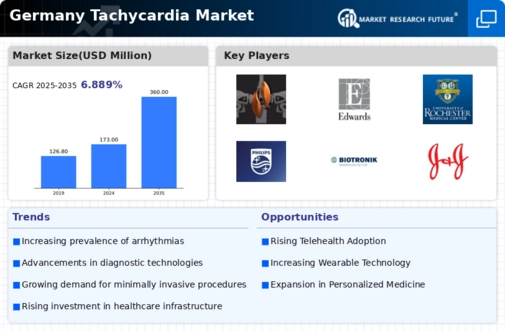The Germany Tachycardia Market has become increasingly competitive as various healthcare companies recognize the growing prevalence of tachycardia and seek to offer solutions that cater to both healthcare providers and patients. This market is driven by advancements in technology, increased awareness of cardiac health, and a rising aging population that is more susceptible to heart-related issues. Companies are investing heavily in research and development to innovate and enhance their product offerings, which include diagnostic devices, ablation tools, and monitoring systems, contributing to the dynamic environment.
In this competitive landscape, organizations employ various strategies such as partnerships, collaborations, and mergers to bolster their market presence and diversify their product lines, thereby ensuring they meet the specific needs of healthcare providers and patients in Germany.Medtronic holds a significant position in the Germany Tachycardia Market, recognized for its commitment to improving patient outcomes through innovative medical technology. The company boasts a strong portfolio of products that include advanced cardiac devices, ablation catheters, and comprehensive software solutions aimed at achieving efficient diagnosis and treatment of tachycardia.
Medtronic's strength lies in its robust research capabilities, coupled with its vast distribution network, enabling it to maintain a reliable supply of medical devices throughout Germany. The company's emphasis on education and training for healthcare professionals further enhances its profile, establishing it as not just a product provider but a key player in the healthcare ecosystem that supports doctors in delivering optimal patient care.Stereotaxis is another vital entity operating within the Germany Tachycardia Market, particularly known for its innovative robotic technologies and catheter navigation systems.
The company has developed a niche with its advanced solutions that allow for precise and safe procedures in cardiac ablation.
Stereotaxis's strengths are amplified by its cutting-edge products, including the Niobe robotic magnetic navigation system, designed to facilitate minimally invasive heart surgery. With a solid presence in Germany, Stereotaxis has also strategically engaged in partnerships and collaborations to strengthen its market stance and enhance technological capabilities. Recent mergers and acquisitions aimed at expanding its operational capacity underscore the company’s commitment to innovation and leadership in the field. Through ongoing efforts, Stereotaxis aims to drive advancements in the treatment of tachycardia, directly improving patient outcomes and solidifying its market share in Germany.




















Leave a Comment